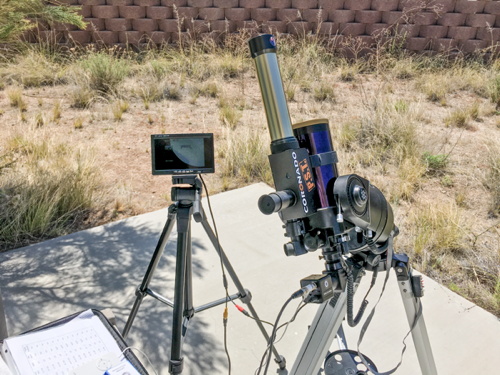Revolution Imager Solar Observing with ETX-90RA and PST
Posted: 12 June 2016
Friday, 10 June 2016, was mostly overcast, with three brief thundershowers in the afternoon (0.3" rain). I received good news on Friday: the replacement 12" LX600 telescope will be shipped soon. Saturday, 11 June, was mostly cloudy. Sunday, 12 June, dawned clear.
Equipment Used:
ETX-90RA
1.25" 26mm eyepiece
PST
1.25" 12.5mm eyepiece
Camera:
Revolution Imager
0950-1100 MST: set up the ETX-90RA and PST (Coronado Personal Solar Telescope) on the house patio for some solar observing. I wanted to check out the Revolution Imager for solar observing in white light (using the Coronado White Light Solar Filter with the ETX) as well as H-Alpha (with the PST). Here are the telescopes and Imager:

I first viewed the Sun through the ETX at 48X and then using the Wide-Field Adapter (WFA). Sunspots AR2553 and AR2554/2552 were nicely visible. With the PST at 32X some good details were visible on the solar disk but only a few small prominences were visible.
I then mounted the Revolution Imager on the ETX using the Wide-Field Adapter. Since I had no sunshade for the monitor it was very difficult to see the image from the camera. This made focusing and determining the appropriate camera settings challenging. I was able to finally get the image in focus and adjusted:

Unfortunately, since I was photographing the screen, reflections were a problem. But as you can see, using the WFA I was not able to view the entire solar disk with the Imager. I added the Imager's 0.5X focal reducer while still using the WFA but the image would not reach a focus.
I then mounted the Imager with the 0.5X focal reducer on the top eyepiece holder. The entire disk was not imaged in the camera field-of-view:

I was never able to see any of the small sunspots on the monitor while using the lower magnifications. Whether that was due to the difficult viewing conditions without a sunshield or whether the Sun was overexposed, I don't know.
I removed the focal reducer and this time I was able to get sunspot AR2553 (below center):

Next, I mounted the Revolution Imager on the PST with and without the focal reducer. As with my past PST imaging attempts when using a DSLR, I was never able to achieve a good focus (due to limited focus travel). This image (without the focal reducer) shows what I was able to get:

Certainly not good enough to image the prominences.
But this exercise did allow me to get some initial settings for the Revolution Imager for the Sun. I have updated the Revolution_Imager_settings.xlsx file.
I then took this handheld iPhone 6s Plus afocal photo of the Sun as seen at 32X in the PST:

Three prominences are visible about 3 o'clock on the Sun's limb with AR2553 just to their left.
This handheld iPhone afocal 48X photo was taken through the ETX, with AR2553 at the right and AR2554/2552 at the left:

I plan to do more solar work with the Revolution Imager after I receive the replacement 12" LX600 telescope.
If you haven't seen it already, check out the The New World Atlas of Artificial Sky Brightness. Also see this article: 80% of World Population Lives Under Skyglow, New Study Finds.
Comments are welcome using Email. Twitter users can use the button below to tweet this report to your followers. Thanks.
Cassiopeia Observatory Home Page
Copyright ©2016 Michael L. Weasner / mweasner@me.com
URL = http://www.weasner.com/co/Reports/2016/06/12/index.html
